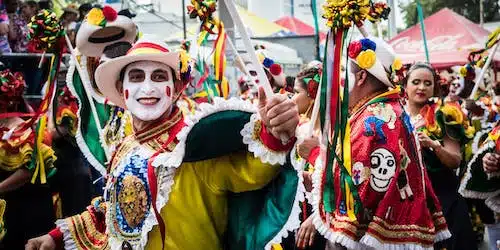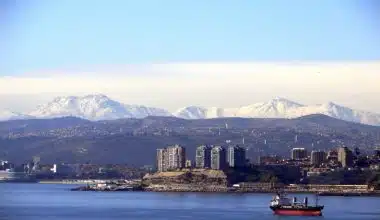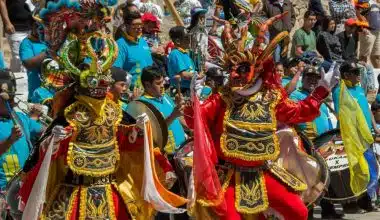Discover the enchanting tapestry of celebrations and traditions as we dive into the vibrant mosaic of holidays in Colombia, where each festivity reflects the rich cultural diversity. Colombia’s calendar features a diverse range of religious and civic celebrations, reflecting its rich cultural heritage. Major holidays in Colombia have significant dates for their cultural celebrations, religious observance, historical commemorations, family bonding, and promotion of tourism.
Holidays In Colombia
Colombia has a rich calendar of holidays, with a mix of religious and civic celebrations. The country has a diverse range of holidays and celebrations that reflect its rich cultural heritage and traditions.
Major Holidays In Colombia
- New Year’s Day (Ao Nuevo) – January 1st.
- Epiphany (Da de los Reyes Magos) – January 6th.
- Saint Joseph’s Day (Da de San Jos) – March 19th.
- Maundy Thursday (Jueves Santo) – Thursday before Easter Sunday, variable dates in March or April.
- Good Friday (Viernes Santo) – Friday before Easter Sunday, variable dates in March or April.
- Labour Day (Primero de Mayo) – May 1st.
- Ascension of Jesus (Ascensin del seor) – 39 days after Easter Sunday.
- Corpus Christi – 60 days after Easter Sunday.
- Sacred Heart (Sagrado Corazn) – 68 days after Easter Sunday.
- Saint Peter and Saint Paul (San Pedro y San Pablo) – June 29th.
- Independence Day (Independence Day) – July 20th.
- Battle of Boyac Day (Battle of Boyac Day) – August 7th.
- Assumption of Mary (Assumption of Mary) – August 15th.
- Columbus Day (Columbus Day) – October 16th.
- All Saints’ Day (All Saints’ Day) – November 1st.
- Independence of Cartagena (Independence of Cartagena) – November 11th.
- Colombian Women’s Day (Colombian Women’s Day) – November 14th.
- Feast of the Immaculate Conception (Feast of the Immaculate Conception): December 8th.
- Christmas Day (Christmas Day): December 25th
The holidays in Colombia hold significant cultural, historical, and social importance.
Significance of Holidays in Colombia
#1. Cultural Celebrations
Colombia is known for its vibrant and colourful festivals and carnivals. These celebrations showcase the rich cultural heritage of the country, including music, dance, costumes, and traditional rituals. Festivals like the Carnaval de Barranquilla and the Carnaval de Negros y Blancos attract thousands of visitors and provide a platform for artistic expression and cultural pride.
#2. Religious Observances
Many holidays in Colombia are based on the Catholic calendar and hold religious significance. Semana Santa (Holy Week) is a particularly important celebration, observed throughout the country with processions, rituals, and religious ceremonies. Cities like Popayn are renowned for their elaborate Semana Santa festivities, which attract both locals and tourists.
#3. Historical Commemorations
Several holidays in Colombia commemorate important historical events and milestones in the country’s history. For example, Independence Day on July 20th marks Colombia’s independence from Spanish rule. The Battle of Boyac Day on August 7th commemorates the victory that led to Colombia’s independence. These holidays serve as reminders of Colombia’s struggle for freedom and national identity.
#4. Family and Community Bonding
Holidays in Colombia provide opportunities for families and communities to come together, spend quality time, and strengthen bonds. Christmas Eve, for instance, is a significant celebration where families gather for a big dinner, exchange gifts, and enjoy festive traditions. It is a time of joy, unity, and sharing among loved ones.
#5. Promotion of Tourism
Festivals and holidays in Colombia attract both domestic and international tourists. These events showcase the country’s cultural diversity, traditions, and natural beauty. They contribute to the local economy and promote Colombia as a vibrant and exciting tourist destination.
#6. Employee Benefits
Holidays in Colombia also provide employees with paid time off, allowing them to rest, recharge, and spend time with family and friends. These benefits contribute to work-life balance and overall well-being.
#7. Cultural Preservation
Holidays in Colombia play a crucial role in preserving and promoting the country’s rich cultural heritage. Festivals and celebrations showcase traditional music, dance, costumes, and culinary traditions, allowing for the passing down of cultural practices from one generation to another.
#8. Tourism and Economic Impact
Many holidays and festivals in Colombia attract both domestic and international tourists. These events contribute to the local economy by boosting tourism, creating employment opportunities, and supporting local businesses such as hotels, restaurants, and artisans.
#9. Community Engagement
Holidays provide opportunities for communities to come together, strengthen social bonds, and foster a sense of belonging. Festivals and celebrations often involve active participation from community members, promoting unity and solidarity.
#10. Religious Devotion
Many holidays in Colombia have religious origins and hold deep spiritual significance for the population. These holidays provide opportunities for individuals to express their faith, participate in religious ceremonies, and engage in acts of devotion.
Festive Periods That Take Place In Colombia
Colombia is known for its vibrant and diverse festivals throughout the year.
#1. Bogota International Book Fair
The Bogota International Book Fair is a major literary festival that takes place in April or May. It attracts writers, illustrators, publishers, and book lovers from around the world. The event features a massive trade fair, talks, workshops, concerts, exhibitions, and a children’s programme. It celebrates literature and promotes cultural exchange.
#2. Festival of the Flowers
The Festival of the Flowers is a colorful celebration held in Medellin. It showcases the region’s vibrant flower industry and cultural heritage. The festival includes parades, flower exhibitions, music, dance, and various cultural events. It promotes tourism, highlights the beauty of Colombian flowers, and fosters community engagement.
Considered one of the largest carnivals in the world, the Carnaval de Barranquilla is a vibrant celebration of music, dance, and cultural traditions. It takes place in Barranquilla and attracts thousands of visitors and participants. The carnival features parades, costumes, music performances, and traditional dances. It is a significant folkloric and cultural holiday in Colombia.
The Feria de Manizales and Carnaval de Negros y Blancos are two major festivals celebrated in Manizales. The Feria de Manizales is a week-long event that includes bullfighting, concerts, parades, and cultural activities. The Carnaval de Negros y Blancos is known for its vibrant displays of black and white face paint, representing the fusion of indigenous and African cultures. Both festivals showcase the region’s cultural heritage and attract tourists.
#5. Cali Fair
The Cali Fair is one of the most significant events in Cali, attracting visitors and tourists from around the world. It is a week-long celebration of salsa music, dance, and culture. The fair features salsa concerts, dance competitions, parades, and fireworks. It showcases Cali’s reputation as the salsa capital of the world and promotes cultural tourism.
#6. Semana Santa
Semana Santa, or Holy Week, is a religious observance celebrated throughout Colombia. It includes processions, religious ceremonies, and reenactments of the Passion of Christ. Cities like Popayan, Mompox, and Pamplona are known for their elaborate Semana Santa celebrations. It is a time for reflection, devotion, and cultural expression.
#7. Blacks and Whites’ Carnival
The Blacks and Whites’ Carnival in Pasto is one of the most ancient carnivals in the Americas. It combines elements from European, African, and Amerindian cultures. The carnival features parades, dances, music, and the nomination of a beauty queen. It has been recognised as a masterpiece of the oral and intangible heritage of humanity by UNESCO. The carnival celebrates cultural diversity and heritage.
#8. Festival of Lights (Festival de Luces)
Held in Medellin in December, the Festival of Lights is a dazzling Christmas celebration. The city is adorned with elaborate light displays, creating a magical atmosphere. The festival includes concerts, parades, fireworks, and cultural activities, attracting locals and tourists alike.
#9. Festival de la Leyenda Vallenata
This festival celebrates vallenato music, a traditional Colombian genre. It takes place in Valledupar and features music competitions, concerts, and cultural events. The festival showcases the talent of Vallenato musicians and preserves the cultural heritage of the region.
#10. Festival del Diablo
The Festival del Diablo (Devil’s Festival) is a unique celebration held in Riosucio, Caldas. It combines indigenous, Spanish, and African traditions. Participants dress up as devils and angels, engaging in lively dances and parades. The festival represents the struggle between good and evil and is a vibrant display of cultural fusion.
Activities And Places To Explore In Colombia
During the holidays in Colombia, there are plenty of activities and places to explore.
#1. Visit Cartagena
Cartagena is a vibrant and historic city known for its colourful colonial architecture, cobblestone streets, and beautiful beaches.
#2. Explore Tayrona National Park
Located along Colombia’s Caribbean coast, Tayrona National Park offers stunning beaches, hiking trails, and the opportunity to experience the country’s natural beauty.
#3. Discover the Cocora Valley
Located in the Coffee Triangle region, the Cocora Valley is famous for its towering wax palm trees, scenic landscapes, and hiking trails.
Considered one of the largest carnivals in the world, the Carnaval de Barranquilla is a vibrant celebration of music, dance, and culture that takes place in Barranquilla.
#5. Visit the Ruins of San Agustn and Tierradentro
These archaeological sites offer a glimpse into Colombia’s ancient past, with impressive stone statues and underground tombs.
#6. Explore the Colonial City of Popayan
Known for its well-preserved colonial architecture, Popayn offers a charming atmosphere and a rich cultural heritage.
#7. Celebrate New Year’s Eve with Family
In Colombia, it is common to spend New Year’s Eve with family, enjoying a big dinner, drinks, and traditional Colombian music.
#8. Try Colombian Cuisine
Colombia offers a diverse culinary scene, with dishes like arepas, bandeja paisa, empanadas, and the famous Colombian coffee to indulge in.
#9. Participate in Local Festivals
Throughout the year, Colombia hosts various festivals celebrating music, dance, and cultural traditions. These festivals provide a unique opportunity to immerse yourself in Colombian culture.
#10. Enjoy the Natural Beauty
Colombia is known for its stunning landscapes, including lush rainforests, coffee plantations, and picturesque beaches. Take the time to explore and appreciate the country’s natural wonders.
What Are The Main Holidays In Colombia?
The main holidays celebrated in Colombia include New Year’s Day, Epiphany, Holy Week, Labor Day, Independence Day, Battle of Boyacá, Feast of the Immaculate Conception, and Christmas Day. These holidays represent religious, historical, and cultural significance in Colombia, observed with various traditions and celebrations throughout the country.
How Many Federal Holidays Does Colombia Have?
Colombia has a total of 18 holidays, which include 12 Catholic holidays, 6 civic holidays, and additional holidays such as Palm Sunday and Easter Sunday. The city of Barranquilla also has two extra holidays, celebrating Monday and Tuesday of Carnival. The holidays in Colombia encompass a range of religious, historical, and cultural observances, providing opportunities for celebrations, reflection, and national pride.
What Is the Biggest Celebration in Colombia?
The biggest celebration in Colombia is the Carnival of Barranquilla. It is considered the second-largest carnival celebration in the world, after the one in Rio de Janeiro. The carnival takes place in Barranquilla and lasts for several days, starting on the Saturday before Ash Wednesday and ending on the Tuesday immediately after. It is a vibrant and colourful festival that showcases the rich cultural heritage of Colombia, featuring parades, parties, music, dance, and elaborate costumes. The Carnival of Barranquilla attracts nearly one million participants, including both locals and visitors, making it a significant and highly anticipated event in the country.
What Is The Holiday On July 3 In Colombia?
There is no specific holiday mentioned on July 3rd in Colombia. The closest significant holiday around that time is Independence Day, which is celebrated on July 20th. This holiday commemorates the declaration of independence of the Republic of Colombia from Spanish rule. It is a day of national pride and is celebrated with parades, marches, fireworks, and various cultural activities throughout the country.
What Is Colombia’s Currency?
The currency of Colombia is the Colombian peso (COP). The Colombian peso is divided into 100 centavos. Banknotes in Colombia are available in denominations of 1,000, 2,000, 5,000, 10,000, 20,000, 50,000, and 100,000 pesos. Coins are minted in denominations of 50, 100, 200, 500, and 1,000 pesos. The symbol for the Colombian peso is “$” and it is commonly used in prices and transactions in the country. The Colombian peso is managed and issued by the Banco de la República, which is the central bank of Colombia.
What Is Colombia Best Known For?
Colombia is known for its geographical diversity, including coastlines on both the Pacific Ocean and the Caribbean Sea, as well as stunning beaches, rainforests, mountains, and the Amazon rainforest. The country has a rich cultural heritage, with a vibrant music scene, traditional sports like Tejo, and a passion for football. Colombian coffee is highly regarded worldwide for its exceptional quality. The Carnival of Barranquilla is the biggest celebration in Colombia, showcasing the country’s cultural heritage through parades, music, dance, and costumes. Colombia is also known for its natural resources, including emeralds. The warmth and welcoming nature of the Colombian people are also widely recognized.
Conclusion
Colombia’s holidays promote family bonding and strengthen bonds among communities, contributing to the local economy. Colombia hosts several vibrant festivals throughout the year, including the Bogota International Book Fair, Festival of the Flowers, Carnaval de Barranquilla, Feria de Manizales, Carnaval de Negros y Blancos, and Cali Fair. These events celebrate literature, the flower industry, music, dance, and cultural heritage, attracting visitors and promoting tourism in Colombia. Enjoy Colombian cuisine, participate in local festivals, and appreciate the country’s natural beauty, including lush rainforests and coffee plantations.
- WHAT CONTINENT IS ARMENIA IN?
- IS IT SAFE TO TRAVEL TO COLOMBIA RIGHT NOW?
- COLORADO ROAD TRIP: All You Need To Know
- THE ULTIMATE LIST OF COLOMBIA CITIES
- CHEAPEST COUNTRIES TO VISIT


